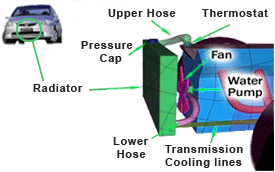
The cooling system in a vehicle/engine consists of a water pump to circulate the Coolant through the engine block and heads and pick up heat. The heated fluid then makes its way through a rubber hose to the radiator. As it flows through the thin tubes in the radiator, the hot liquid is cooled by the air stream entering the engine compartment from the grill in front of the vehicle/engine. Once the fluid is cooled, it returns to the engine to absorb more heat. The system is also provided with a radiator cap to control the pressure, a thermostat to control the temperature of the Coolant and a heater system where hot Coolant is used to warm up the engine’s interior in extreme winter.
Coolant- cum- Antifreeze is a fluid which flows through an engine in order to prevent its overheating, and also does not freeze in extreme winter. An ideal Coolant has high thermal capacity, low viscosity, is low-cost, and is chemically inert, neither causing nor promoting corrosion of the cooling system. It is a solution of a suitable organic chemical most often ethylene glycol, diethylene glycol, or propylene glycol in water which can withstand temperatures below 0°C and boiling point above 100°C.
Coolant- cum- Antifreeze must meet standards that are set by the vehicle/engine manufacturers.It may also meet the standards set by TS,BS,JIS,etc.